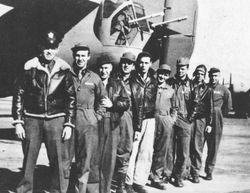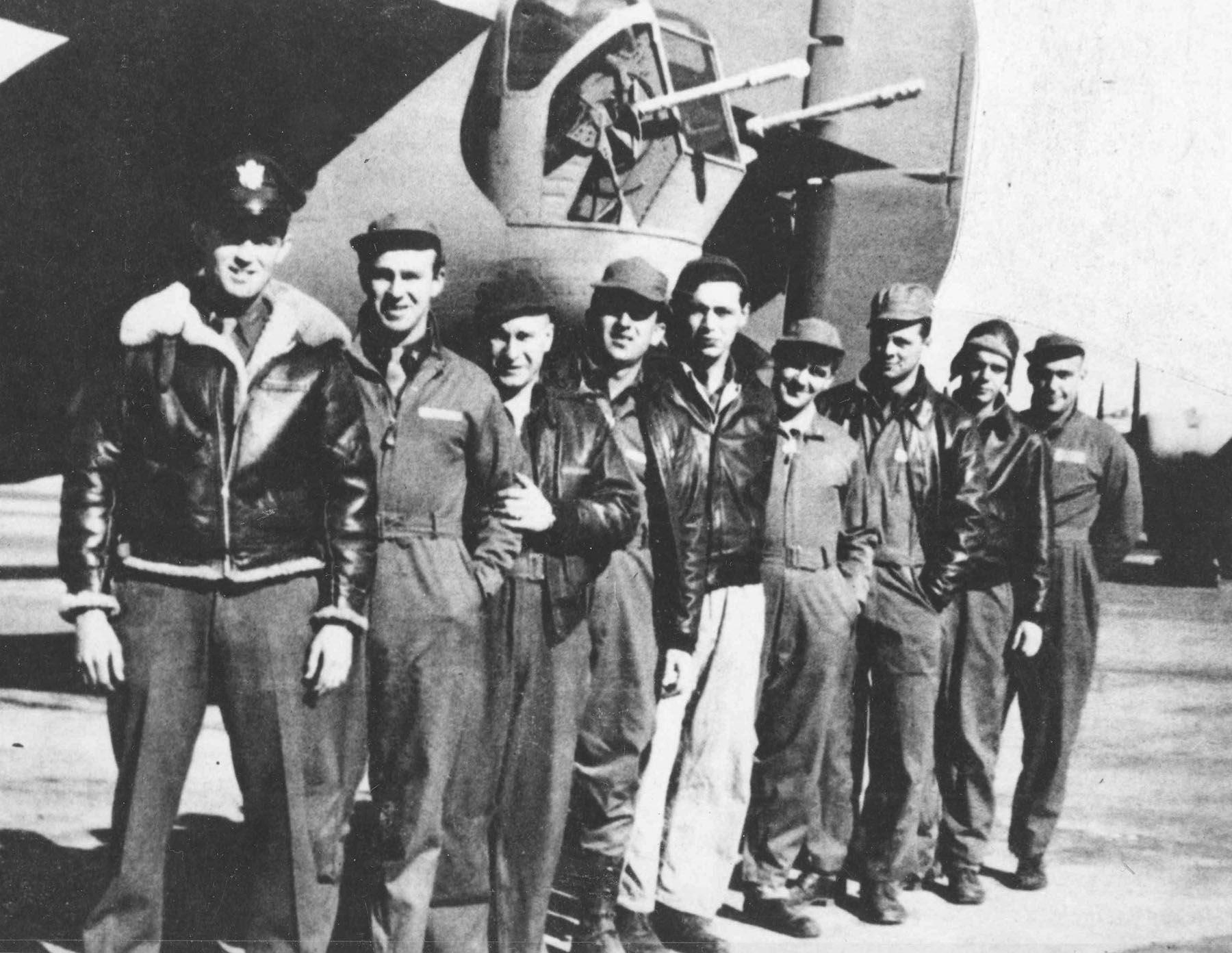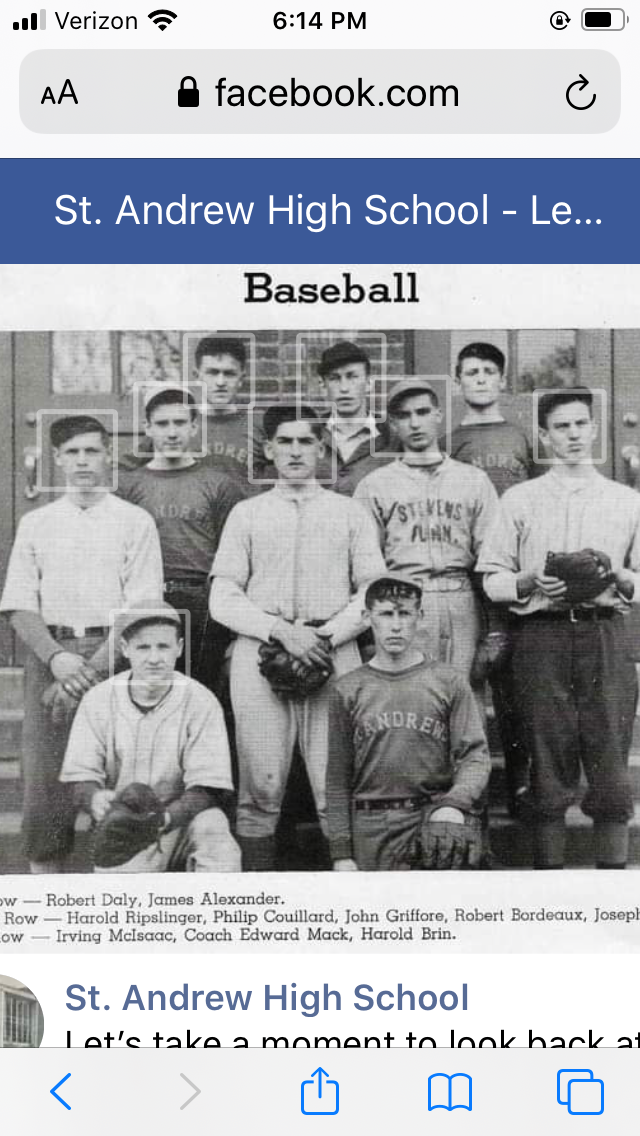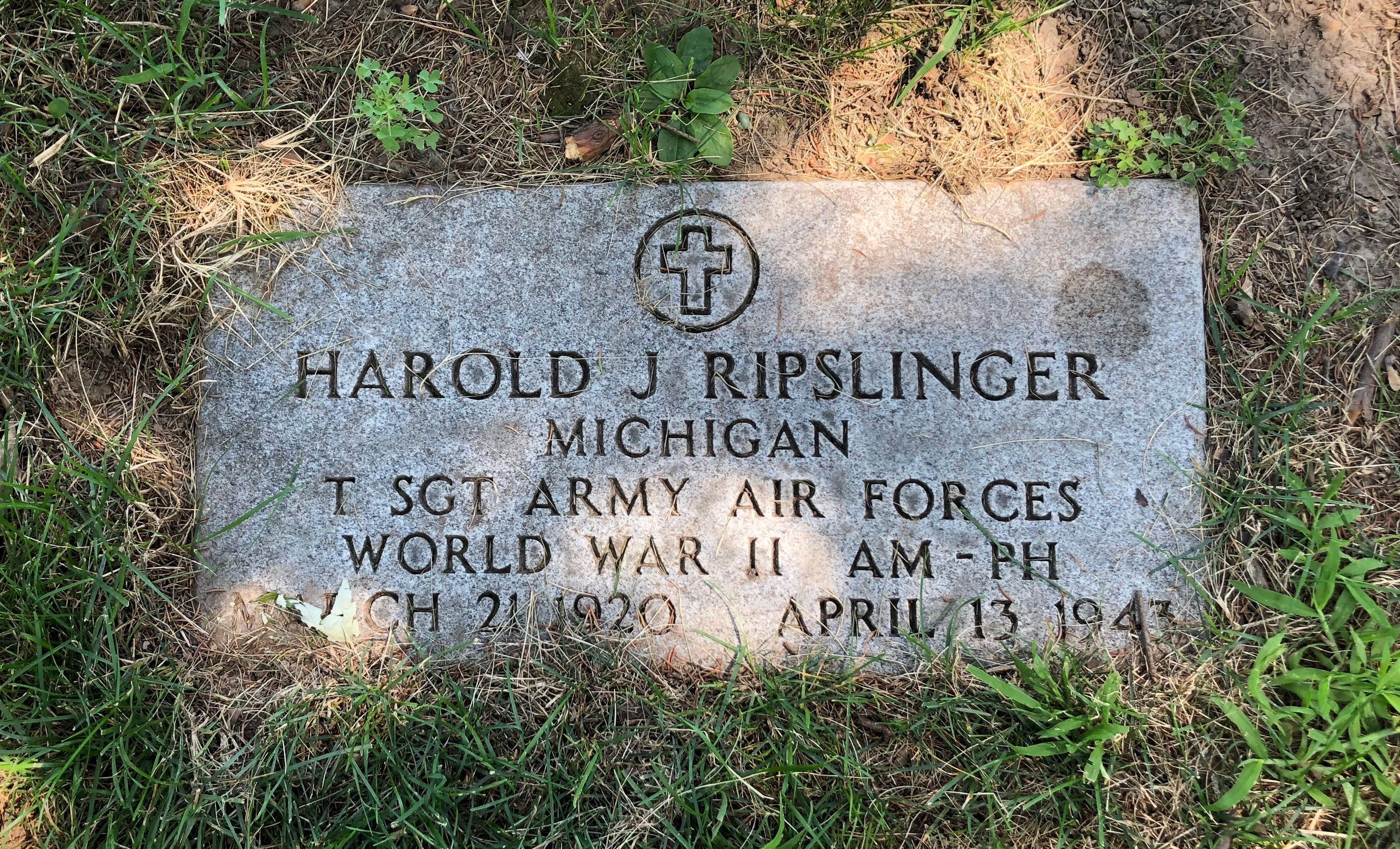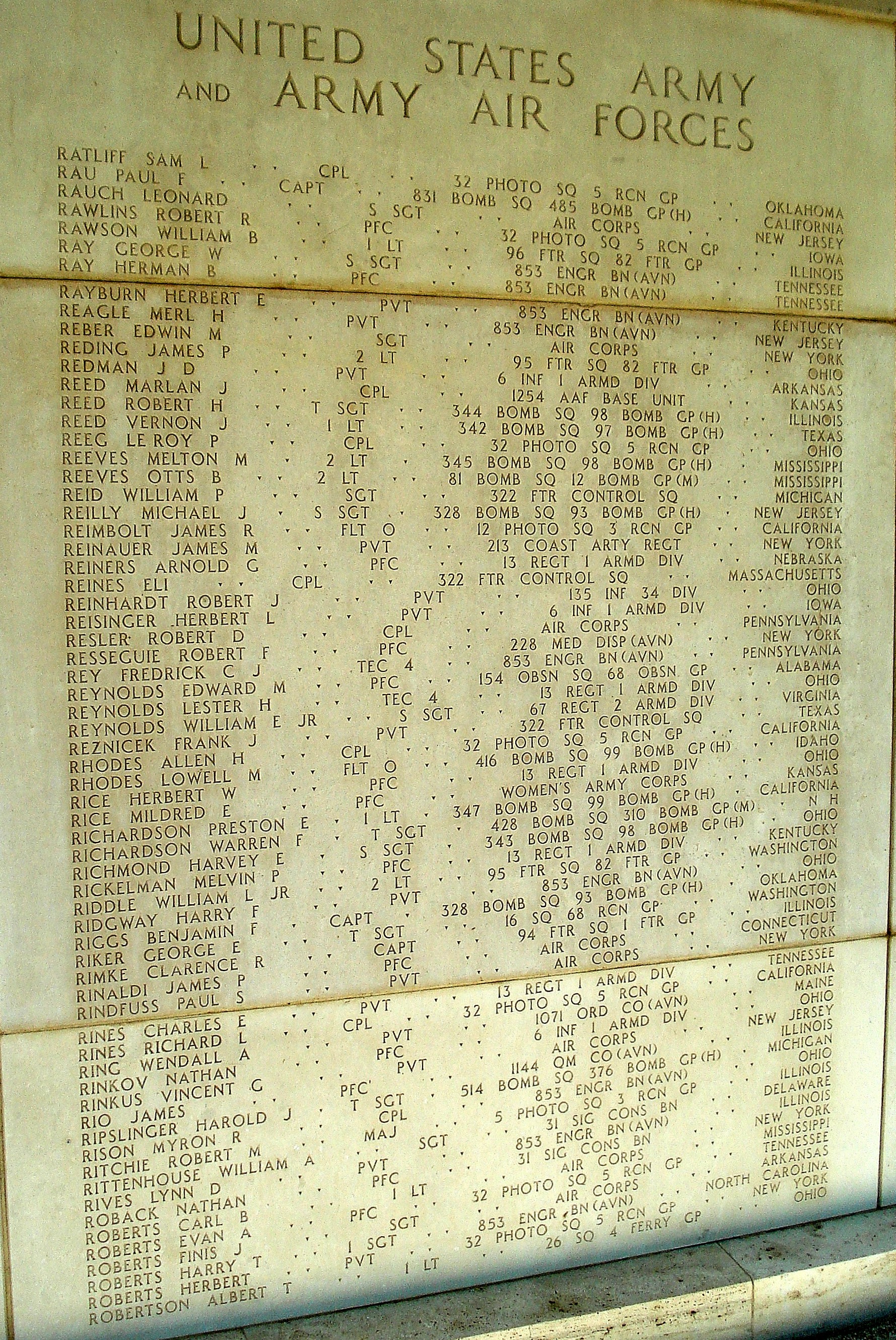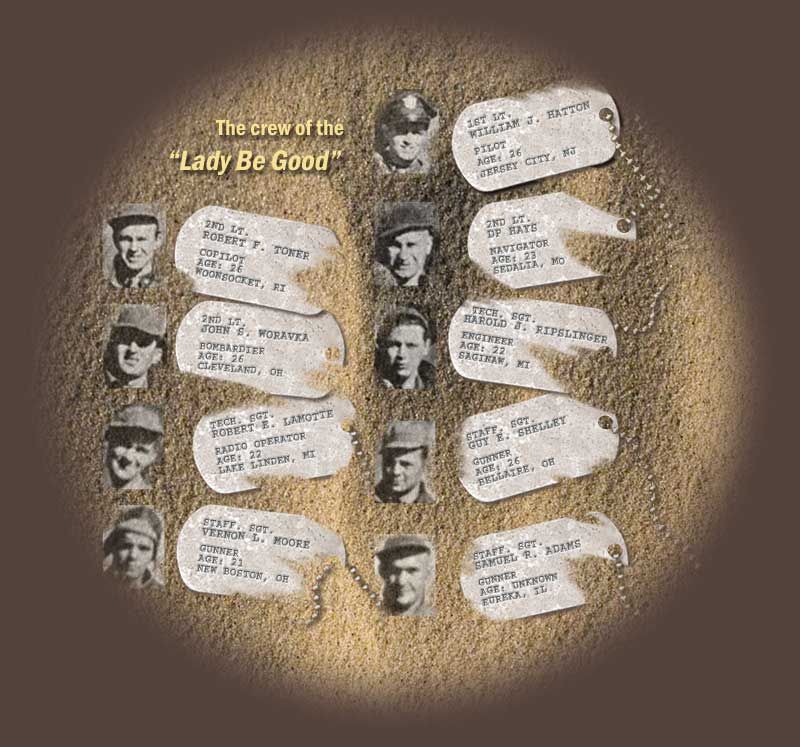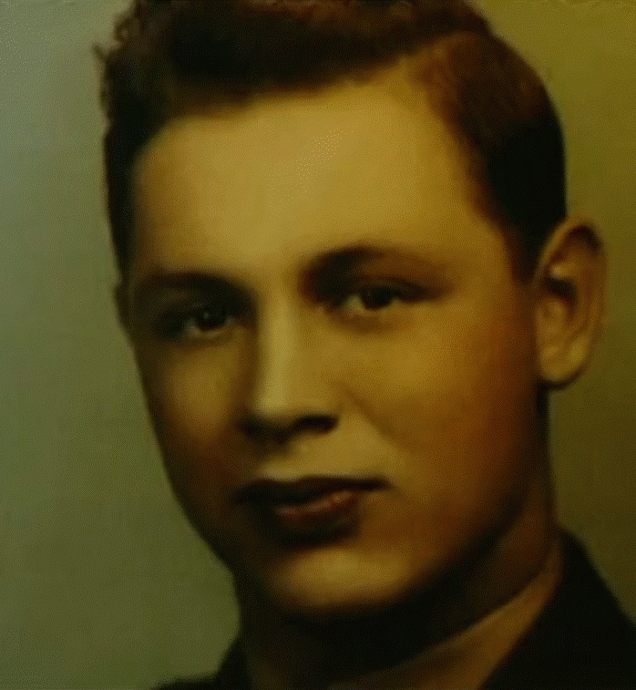Harold enlisted in the Army on December 20, 1941 in Detroit, Michigan. He was noted, at the time of his enlistment, as being employed as a driver and also as single, without dependents.
Harold served as a Technical Sergeant and Engineer / Gunner on B-24D #41-24301 "Lady Be Good", 514th Bomber Squadron, 376th Bomber Group, Heavy, U.S. Army Air Force during World War II. Not only was The Lady Be Good making her maiden voyage into combat on April 4, 1943, but so was the entire crew. She took off from a makeshift airbase located on the coast of Libya, for a bombing mission over the bay of Naples. Without smaller fighter plane protection, all communication was to be silenced until the mission had been completed, so as to avoid being detected by German night fighter planes. Once the Lady Be Good left base, she was never heard from again. The Lady Be Good never made it back to base. The assumption was that they had crashed into the Mediterranean. Search planes were sent out the next morning, but found no floating wreckage and no signs of any crew. Families were notified and, eventually the official word from the Army Air Force was that the crew was missing and presumed dead.
In May of 1958, during an aerial survey by a British oil exploration team, they spotted what looked like a World War II era plane. In March 1959 a ground geological team visited the aircraft and it was confirmed to be The Lady Be Good. The crew, except for SSgt. Moore, was eventually recovered in March of 1960.
Airmen who perished on B-24D #41-24301:
Adams, Samuel E. ~ S/Sgt, Tail Gunner, IL
Hatton, William J. ~ 1st Lt, Pilot, NY
Hays, Dp ~ 2nd Lt, Navigator, MO
La Motte, Robert E. ~ T/Sgt, Radio Operator, MI
Moore, Vernon L. ~ S/Sgt, Gunner, OH
Ripslinger, Harold J. ~ T/Sgt, Engineer, MI
Shelley, Guy E., Jr. ~ S/Sgt, Gunner, PA
Toner, Robert F. ~ 2nd Lt, Co-Pilot, MA
Woravka, John S. ~ 2nd Lt, Bombardier, OH
Both Ripslinger and Toner jotted notes in a diary while in the dessert. Ripslinger's reads:
Monday, April 5. All but Woravka met this A.M. Waited a while and started walking. Had ½ sandwich & piece of candy & cap of water in last 36 hr.
Tuesday, April 6. Started out early walking & resting. It's not sundown and still going. One teaspoon of water today. The rest of the boys are doing fine.
Wednesday, April 7. Started early A.M. and walked til about near spent. Terrible hot afternoons. Started again at 6 P.M. and walked all night. One spoon full of water is all.
Friday, April 9. 5th day out and we all thought we're gone. All wanted to die during noon it was so hot. Morn & nite okay.
Saturday, April 10. Walked all day and night. Suggested Guy, Moore and I make out alone.
Palm Sunday. Still struggling to get out of dunes and find water.
Toner's diary was printed in the March 1960 issue of Life Magazine. It reads:
April 4, 1943
Naples: 28 planes. Things pretty well mixed up. Got lost returning, out of gas, jumped, landed in desert at 2 in morning. No one badly hurt. Can't find John, all others present.
Monday 5.
Start walking NW. Still no John. A few rations, 1/2 canteen of water, 1 cup full per day. Sun fairly warm, good breeze from N.W. Nite very cold. No sleep. Rested and walked.
Tuesday
Rested at 11:30, sun very warm, no breeze. Spent P.M. in hell. No planes, etc. Rested until 5 P.M. Walked and rested all night, 15 min. on, 5 off.
Wednesday
Same routine, everyone getting weak, can't get very far, prayers all the time, again P.M. very warm, hell. Can't sleep. Everyone sore from ground.
Thursday
Hit sand dunes, very miserable, good wind but continuous blowing of sand, everybody now very weak, thought Sam and Moore were all gone. LaMotte's eyes are gone, everyone else's eyes are bad. Still going N.W.
Friday 9.
Shelley, Rip, Moore separate and try to go for help, rest of us all very weak, eyes bad. Not any travel, all want to die, still very little water, nites are about 35°, good N. wind, no shelter, 1 parachute left.
SATURDAY, Apr 10.
Still having prayer meetings for help. No signs of anything, a couple of birds, good wind from N. Really weak now, can't walk, pains all over, still all want to die. Nights very cold, no sleep.
SUNDAY 11.
Still waiting for help, still praying, eyes bad, lost all our wgt., aching all over, could make it if we had some water, just enough left to put our tongue to, have hope for help very soon, no rest, still same place.
MONDAY 12. No help yet. Very cold night.
-------------------------------------------------------------------------------------------------------------------
"The dauntless courage and tenacity of these men in the face of danger, their suffering and unthinkable deprivation, will remain a high point of human achievement against the most severe adversities. The men of the Lady Be Good have given desert survival schools a new gauge with which to indoctrinate their students; a measuring stick that may save other lives."
- excerpt from Mystery Bomber of World War II The Lady Be Good by Dennis E. McClendon, Lt. Col. USAF, Ret.
Harold was first declared Missing In Action in April of 1943. He was posthumously awarded the Air Medal and the Purple Heart; service # 16043686. His remains were found in the Libyan Desert and recovered in March of 1960. Harold is interred at the Saint Andrew Catholic Cemetery with his mother and father, grandparents and all his siblings in his hometown of Saginaw, Michigan. A rosette was placed in front of his name at this North Africa American Cemetery to signify that his remains were recovered.
Harold enlisted in the Army on December 20, 1941 in Detroit, Michigan. He was noted, at the time of his enlistment, as being employed as a driver and also as single, without dependents.
Harold served as a Technical Sergeant and Engineer / Gunner on B-24D #41-24301 "Lady Be Good", 514th Bomber Squadron, 376th Bomber Group, Heavy, U.S. Army Air Force during World War II. Not only was The Lady Be Good making her maiden voyage into combat on April 4, 1943, but so was the entire crew. She took off from a makeshift airbase located on the coast of Libya, for a bombing mission over the bay of Naples. Without smaller fighter plane protection, all communication was to be silenced until the mission had been completed, so as to avoid being detected by German night fighter planes. Once the Lady Be Good left base, she was never heard from again. The Lady Be Good never made it back to base. The assumption was that they had crashed into the Mediterranean. Search planes were sent out the next morning, but found no floating wreckage and no signs of any crew. Families were notified and, eventually the official word from the Army Air Force was that the crew was missing and presumed dead.
In May of 1958, during an aerial survey by a British oil exploration team, they spotted what looked like a World War II era plane. In March 1959 a ground geological team visited the aircraft and it was confirmed to be The Lady Be Good. The crew, except for SSgt. Moore, was eventually recovered in March of 1960.
Airmen who perished on B-24D #41-24301:
Adams, Samuel E. ~ S/Sgt, Tail Gunner, IL
Hatton, William J. ~ 1st Lt, Pilot, NY
Hays, Dp ~ 2nd Lt, Navigator, MO
La Motte, Robert E. ~ T/Sgt, Radio Operator, MI
Moore, Vernon L. ~ S/Sgt, Gunner, OH
Ripslinger, Harold J. ~ T/Sgt, Engineer, MI
Shelley, Guy E., Jr. ~ S/Sgt, Gunner, PA
Toner, Robert F. ~ 2nd Lt, Co-Pilot, MA
Woravka, John S. ~ 2nd Lt, Bombardier, OH
Both Ripslinger and Toner jotted notes in a diary while in the dessert. Ripslinger's reads:
Monday, April 5. All but Woravka met this A.M. Waited a while and started walking. Had ½ sandwich & piece of candy & cap of water in last 36 hr.
Tuesday, April 6. Started out early walking & resting. It's not sundown and still going. One teaspoon of water today. The rest of the boys are doing fine.
Wednesday, April 7. Started early A.M. and walked til about near spent. Terrible hot afternoons. Started again at 6 P.M. and walked all night. One spoon full of water is all.
Friday, April 9. 5th day out and we all thought we're gone. All wanted to die during noon it was so hot. Morn & nite okay.
Saturday, April 10. Walked all day and night. Suggested Guy, Moore and I make out alone.
Palm Sunday. Still struggling to get out of dunes and find water.
Toner's diary was printed in the March 1960 issue of Life Magazine. It reads:
April 4, 1943
Naples: 28 planes. Things pretty well mixed up. Got lost returning, out of gas, jumped, landed in desert at 2 in morning. No one badly hurt. Can't find John, all others present.
Monday 5.
Start walking NW. Still no John. A few rations, 1/2 canteen of water, 1 cup full per day. Sun fairly warm, good breeze from N.W. Nite very cold. No sleep. Rested and walked.
Tuesday
Rested at 11:30, sun very warm, no breeze. Spent P.M. in hell. No planes, etc. Rested until 5 P.M. Walked and rested all night, 15 min. on, 5 off.
Wednesday
Same routine, everyone getting weak, can't get very far, prayers all the time, again P.M. very warm, hell. Can't sleep. Everyone sore from ground.
Thursday
Hit sand dunes, very miserable, good wind but continuous blowing of sand, everybody now very weak, thought Sam and Moore were all gone. LaMotte's eyes are gone, everyone else's eyes are bad. Still going N.W.
Friday 9.
Shelley, Rip, Moore separate and try to go for help, rest of us all very weak, eyes bad. Not any travel, all want to die, still very little water, nites are about 35°, good N. wind, no shelter, 1 parachute left.
SATURDAY, Apr 10.
Still having prayer meetings for help. No signs of anything, a couple of birds, good wind from N. Really weak now, can't walk, pains all over, still all want to die. Nights very cold, no sleep.
SUNDAY 11.
Still waiting for help, still praying, eyes bad, lost all our wgt., aching all over, could make it if we had some water, just enough left to put our tongue to, have hope for help very soon, no rest, still same place.
MONDAY 12. No help yet. Very cold night.
-------------------------------------------------------------------------------------------------------------------
"The dauntless courage and tenacity of these men in the face of danger, their suffering and unthinkable deprivation, will remain a high point of human achievement against the most severe adversities. The men of the Lady Be Good have given desert survival schools a new gauge with which to indoctrinate their students; a measuring stick that may save other lives."
- excerpt from Mystery Bomber of World War II The Lady Be Good by Dennis E. McClendon, Lt. Col. USAF, Ret.
Harold was first declared Missing In Action in April of 1943. He was posthumously awarded the Air Medal and the Purple Heart; service # 16043686. His remains were found in the Libyan Desert and recovered in March of 1960. Harold is interred at the Saint Andrew Catholic Cemetery with his mother and father, grandparents and all his siblings in his hometown of Saginaw, Michigan. A rosette was placed in front of his name at this North Africa American Cemetery to signify that his remains were recovered.
Bio by: tbickellb
Family Members
Sponsored by Ancestry
Advertisement
Advertisement
